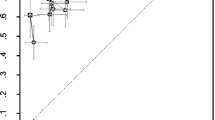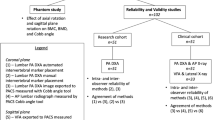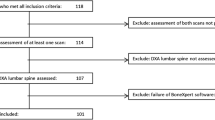Abstract
Absorptiometry of the thoraco-lumbar spine at the time of bone densitometry to detect vertebral deformities consistent with fracture is now available. The performance of absorptiometry in clinical practice compared to radiography has not been fully established, especially in the presence of osteoarthritis or scoliosis. Our first objective was to compare absorptiometry to radiography for detection of vertebral deformity in elderly women who were referred for bone densitometry with or without scoliosis or disc space osteoarthritis excluded. Our second objective was to assess the effect of osteoarthritis and scoliosis on the inter-rater reliability of both technologies. The study group comprised two hundred five women age 65 and older referred for bone densitometry in a large multispecialty group practice. Lateral and antero-posterior (AP) absorptiometry images and lateral spine radiographs were obtained on all participants. The vertebrae on all images were evaluated for vertebral deformity by two observers according to the Genant semiquantitative criteria who were blinded to each other’s readings. Disc spaces were evaluated on radiographs for osteoarthritis. Absorptiometry AP images were evaluated for scoliosis. In the absence of scoliosis, the sensitivity and specificity of absorptiometry for persons with one or more radiographic grade 2–3 deformities (>25% reduction of vertebral height) for the two readers were 87–93% and 93–95%, respectively. The inter-rater reliability of absorptiometry improved in the absence of moderate or severe disc space osteoarthritis. A strategy of absorptiometry with follow-up radiography only in those with scoliosis or apparent grade 2 deformity accurately identifies those with prevalent grade 2 or 3 deformity on radiography (accuracy 0.98 and kappa 0.86 for reader 1; accuracy 0.99 and kappa 0.92 for reader 2). Lateral and AP absorptiometry imaging of the spine with selective follow-up radiography accurately identifies elderly women with vertebral deformity consistent with moderate or severe fracture, but extra caution is necessary when evaluating vertebrae in the presence of adjacent disc space osteoarthritis.



Similar content being viewed by others
References
Ross PD, Genant HK, Davis JW, Miller PD, Wasnich RD (1993) Predicting vertebral fracture incidence from prevalent fractures and bone density among non-black, osteoporotic women. Osteoporos Int 3:120–126
Black DM, Arden NK, Palermo L, Pearson J, Cummings SR (1999) Prevalent vertebral deformities predict hip fractures and new vertebral deformities but not wrist fractures. Study of Osteoporotic Fractures Research Group. J Bone Miner Res 14:821–828
Genant HK, Li J, Wu CY, Shepherd JA (2000) Vertebral fractures in osteoporosis: a new method for clinical assessment. J Clin Densitom 3:281–290
Greenspan SL, von Stetten E, Emond SK, Jones L, Parker RA (2001) Instant vertebral assessment: a noninvasive dual X-ray absorptiometry technique to avoid misclassification and clinical mismanagement of osteoporosis. J Clin Densitom 4:373–380
Schousboe JT, DeBold CR, Bowles C, Glickstein S, Rubino RK (2002) Prevalence of vertebral compression fracture deformity by X-ray absorptiometry of lateral thoracic and lumbar spines in a population referred for bone densitometry. J Clin Densitom 5:239–246
Vokes TJ, Dixon LB, Favus MJ (2003) Clinical utility of dual-energy vertebral assessment (DVA). Osteoporos Int 14:871–878
Abdel-Hamid Osman A, Bassiouni H, Koutri R, Nijs J, Geusens P, Dequeker J (1994) Aging of the thoracic spine: distinction between wedging in osteoarthritis and fracture in osteoporosis—a cross-sectional and longitudinal study. Bone 199415:437–442
Ziegler R, Scheidt-Nave C, Leidig-Bruckner G (1996) What is a vertebral fracture? Bone 18 [Suppl 3]:169S–177S
Rea JA, Li J, Blake GM, Steiger P, Genant HK, Fogelman I (2000) Visual assessment of vertebral deformity by X-ray absorptiometry: a highly predictive method to exclude vertebral deformity. Osteoporos Int 11:660–668
Rea JA, Chen MB, Li J, et al (1999) Morphometric X-ray absorptiometry and morphometric radiography of the spine: a comparison of analysis precision in normal and osteoporotic subjects. Osteoporos Int 9:536–544
Ferrar L, Jiang G, Eastell R (2001) Vertebral wedge angle measured by morphometric X-ray absorptiometry. Osteoporos Int 12:914–921
Ferrar L, Jiang G, Eastell R (2001) Short-term precision for morphometric X-ray absorptiometry. Osteoporos Int 12:710–715
Ferrar L, Eastell R (1999) Identification of vertebral deformities in men: comparison of morphometric radiography and morphometric X-ray absorptiometry. Osteoporos Int 10:167–174
Ferrar L, Jiang G, Barrington NA, Eastell R (2000) Identification of vertebral deformities in women: comparison of radiological assessment and quantitative morphometry using morphometric radiography and morphometric X-ray absorptiometry. J Bone Miner Res 15:575–585
Ferrar L, Jiang G, Eastell R (2001) Longitudinal evaluation of morphometric X-ray absorptiometry for the identification of vertebral deformities. Osteoporos Int 12:661–671
Binkley N, Krueger D, Gangnon R, Genant HK, Drezner MK (2005) Lateral vertebral assessment: a valuable technique to detect clinically significant vertebral fractures. Osteoporos Int (e-pub: http://80-www.springerlink.com.floyd.lib.umn.edu/app/home/issue.asp. Accessed 20 May 2005)
Genant HK, Wu CY, van Kuijk C, Nevitt MC (1993) Vertebral fracture assessment using a semiquantitative technique. J Bone Miner Res 8:1137–1148
Lane NE, Nevitt MC, Genant HK, Hochberg MC (1993) Reliability of new indices of radiographic osteoarthritis of the hand and hip and lumbar disc degeneration. J Rheumatol 20:1911–1918
Brown LP, Cai TT, Das Gupta A (2001) Interval estimation for a binomial proportion. Stat Sci 16:101–117
Delmas PD, Genant HK, Crans GG, et al (2003) Severity of prevalent vertebral fractures and the risk of subsequent vertebral and nonvertebral fractures: results from the MORE trial. Bone 33:522–532
Farahmand BY, Persson PG, Michaelsson K, Baron JA, Parker MG, Ljunghall S (2000) Socioeconomic status, marital status and hip fracture risk: a population-based case-control study. Osteoporos Int 11:803–808
Jiang G, Eastell R, Barrington NA, Ferrar L (2004) Comparison of methods for the visual identification of prevalent vertebral fracture in osteoporosis. Osteoporos Int 15:887–896
Acknowledgements
We are grateful to Lynne Ferrar, PhD (University of Sheffield, U.K.), Guirong Jiang, MD (University of Sheffield, U.K.) and Kevin Wilson, PhD (Hologic, Inc.) for their very helpful comments regarding both the analyses and the manuscript. This study was funded by grants from Hologic, Inc., and the Park Nicollet Institute.
Author information
Authors and Affiliations
Corresponding author
Rights and permissions
About this article
Cite this article
Schousboe, J.T., DeBold, C.R. Reliability and accuracy of vertebral fracture assessment with densitometry compared to radiography in clinical practice. Osteoporos Int 17, 281–289 (2006). https://doi.org/10.1007/s00198-005-2010-5
Received:
Accepted:
Published:
Issue Date:
DOI: https://doi.org/10.1007/s00198-005-2010-5




